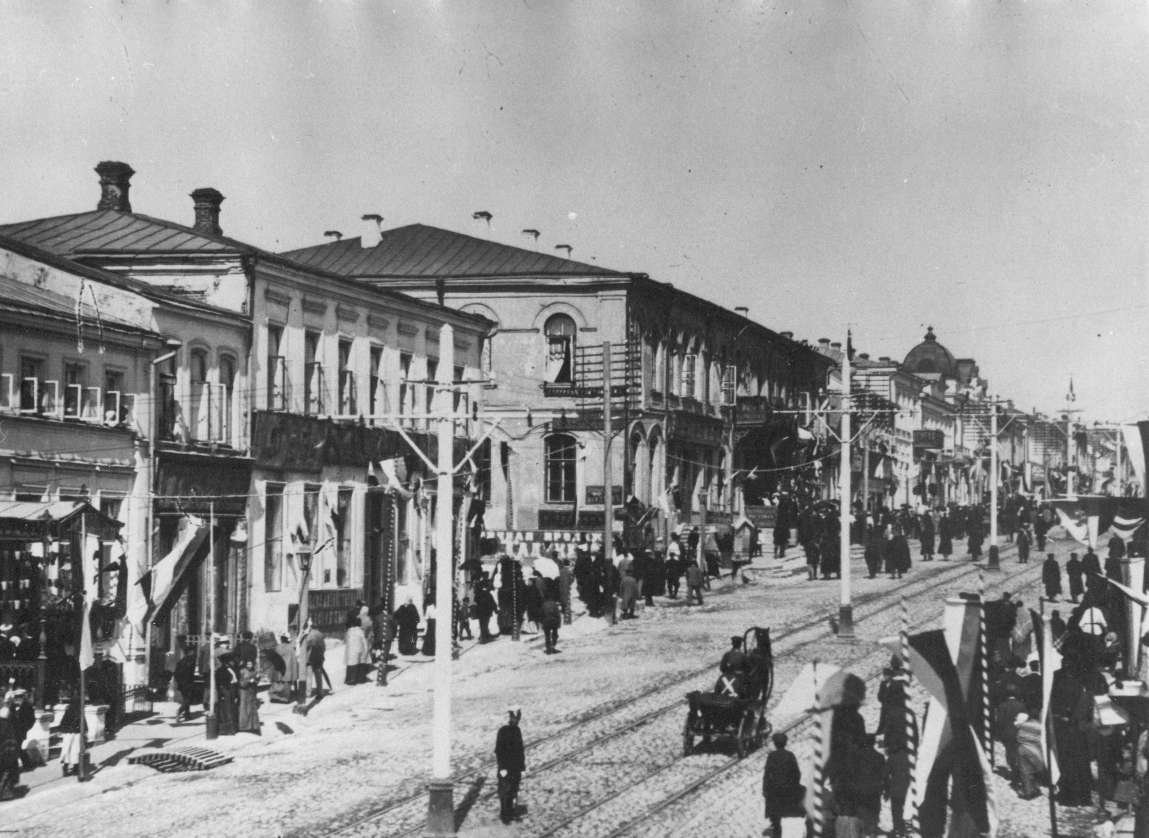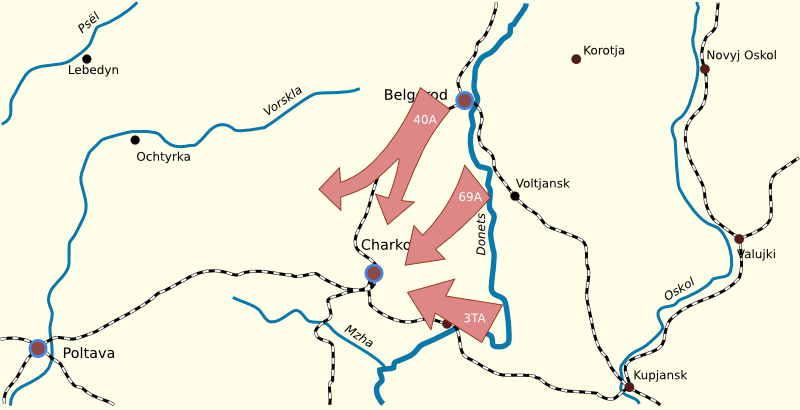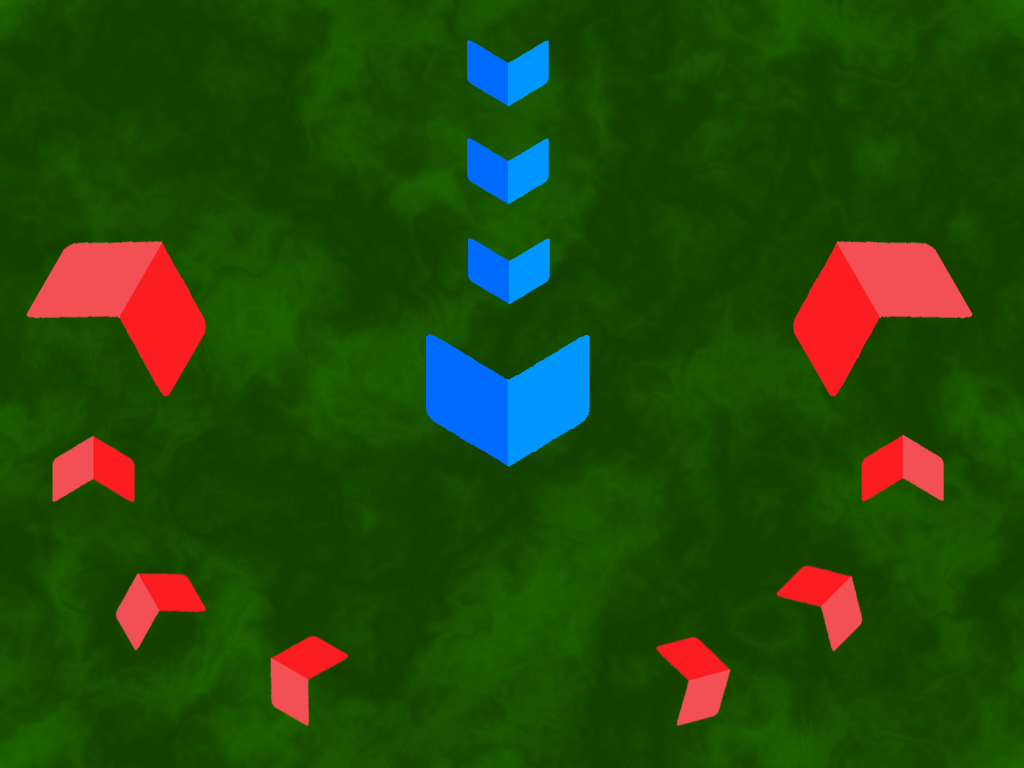|
VoronezhŌĆōKastornoye Offensive
The 1943 Battle of Voronezh or VoronezhŌĆōKastornoye offensive operation (often credited in Russian as the liberation of Voronezh (ąŠčüą▓ąŠą▒ąŠąČą┤ąĄąĮąĖąĄ ąÆąŠčĆąŠąĮąĄąČą░)) was a Soviet counter-offensive on the Eastern Front of World War II on recapturing the city of Voronezh during January 1943. It took place between 24 January and 17 February 1943, as 4th phase of the general Soviet winter offensive of 1942ŌĆō1943, immediately following the OstrogozhskŌĆōRossosh offensive. The Axis had captured Voronezh in a 1942 battle, and the 2nd German Army occupied this important bridgehead over the Don, together with Hungarian troops that had escaped the destruction of the Hungarian 2nd Army during the OstrogozhskŌĆōRossosh offensive. The Red Army executed a new pincer movement in difficult winter conditions. From the south, the troops of the Voronezh Front under command of General Golikov attacked, in collaboration with the left flank of the Bryansk Front under General ... [...More Info...] [...Related Items...] OR: [Wikipedia] [Google] [Baidu] |
Eastern Front (World War II)
The Eastern Front, also known as the Great Patriotic War (term), Great Patriotic War in the Soviet Union and its successor states, and the GermanŌĆōSoviet War in modern Germany and Ukraine, was a Theater (warfare), theatre of World War II fought between the European Axis powers and Allies of World War II, Allies, including the Soviet Union (USSR) and Polish Armed Forces in the East, Poland. It encompassed Central Europe, Eastern Europe, Northern Europe, Northeast Europe (Baltic states, Baltics), and Southeast Europe (Balkans), and lasted from 22 June 1941 to 9 May 1945. Of the estimated World War II casualties, 70ŌĆō85 million deaths attributed to World War II, around 30 million occurred on the Eastern Front, including 9 million children. The Eastern Front was decisive in determining the outcome in the European theatre of World War II, European theatre of operations in World War II, eventually serving as the main reason for the defeat of Nazi Germany and the Axis ... [...More Info...] [...Related Items...] OR: [Wikipedia] [Google] [Baidu] |
Battles And Operations Of The SovietŌĆōGerman War
A battle is an occurrence of combat in warfare between opposing military units of any number or size. A war usually consists of multiple battles. In general, a battle is a military engagement that is well defined in duration, area, and force commitment. An engagement with only limited commitment between the forces and without decisive results is sometimes called a skirmish. The word "battle" can also be used infrequently to refer to an entire operational campaign, although this usage greatly diverges from its conventional or customary meaning. Generally, the word "battle" is used for such campaigns if referring to a protracted combat encounter in which either one or both of the combatants had the same methods, resources, and strategic objectives throughout the encounter. Some prominent examples of this would be the Battle of the Atlantic, Battle of Britain, and the Battle of France, all in World War II. Wars and military campaigns are guided by military strategy, whereas batt ... [...More Info...] [...Related Items...] OR: [Wikipedia] [Google] [Baidu] |
Battles Of World War II Involving Germany
A battle is an occurrence of combat in warfare between opposing military units of any number or size. A war usually consists of multiple battles. In general, a battle is a military engagement that is well defined in duration, area, and force commitment. An engagement with only limited commitment between the forces and without decisive results is sometimes called a skirmish. The word "battle" can also be used infrequently to refer to an entire operational campaign, although this usage greatly diverges from its conventional or customary meaning. Generally, the word "battle" is used for such campaigns if referring to a protracted combat encounter in which either one or both of the combatants had the same methods, resources, and strategic objectives throughout the encounter. Some prominent examples of this would be the Battle of the Atlantic, Battle of Britain, and the Battle of France, all in World War II. Wars and military campaigns are guided by military strategy, whereas ba ... [...More Info...] [...Related Items...] OR: [Wikipedia] [Google] [Baidu] |
Battles Involving The Soviet Union
A battle is an occurrence of combat in warfare between opposing military units of any number or size. A war usually consists of multiple battles. In general, a battle is a military engagement that is well defined in duration, area, and force commitment. An engagement with only limited commitment between the forces and without decisive results is sometimes called a skirmish. The word "battle" can also be used infrequently to refer to an entire operational campaign, although this usage greatly diverges from its conventional or customary meaning. Generally, the word "battle" is used for such campaigns if referring to a protracted combat encounter in which either one or both of the combatants had the same methods, resources, and strategic objectives throughout the encounter. Some prominent examples of this would be the Battle of the Atlantic, Battle of Britain, and the Battle of France, all in World War II. Wars and military campaigns are guided by military strategy, whereas batt ... [...More Info...] [...Related Items...] OR: [Wikipedia] [Google] [Baidu] |
1943 In The Soviet Union
Events Below, the events of World War II have the "WWII" prefix. January * January 1 ŌĆō WWII: The Soviet Union announces that 22 German divisions have been encircled at Stalingrad, with 175,000 killed and 137,650 captured. * January 4 ŌĆō WWII: Greek-Polish athlete and saboteur Jerzy Iwanow-Szajnowicz is executed by the Germans at Kaisariani. * January 10 – WWII: Guadalcanal Campaign: American forces of the 2nd Marine Division and the 25th Infantry Division begin their assaults on the Galloping Horse and Sea Horse on Guadalcanal. Meanwhile, the Japanese 17th Army makes plans to abandon the island and after fierce resistance withdraws to the west coast of Guadalcanal. * January 11 ** The United States and United Kingdom revise previously unequal treaty relationships with the Republic of China. ** Italian-American anarchist Carlo Tresca is assassinated in New York City. * January 12 ŌĆō WWII: Landing at Amchitka: American forces make an unopposed landing on Amchi ... [...More Info...] [...Related Items...] OR: [Wikipedia] [Google] [Baidu] |
Oryol
Oryol ( rus, ą×čĆčæą╗, , ╔É╦łr╩▓╔Ąl, a=ru-ą×čĆčæą╗.ogg, links=y, ), also transliterated as Orel or Oriol, is a Classification of inhabited localities in Russia, city and the administrative center of Oryol Oblast, Russia, situated on the Oka River, approximately south-southwest of Moscow. It is part of the Central Federal District, as well as the Central Economic Region. First founded as a medieval stronghold of the Principality of Chernigov, Oryol was part of Grand Duchy of Lithuania, Lithuania in the Late Middle Ages, late medieval period, and then Russia since the early modern period. It has served as the seat of regional administration since 1778. The city is particularly known for the infamous Oryol Prison, former prison for political and war prisoners of Russian Empire, Tsarist Russia, the Soviet Union and Nazi Germany. History Early history While there are no historical records, archaeological evidence shows that a fortress settlement existed between the Oka River and ... [...More Info...] [...Related Items...] OR: [Wikipedia] [Google] [Baidu] |
Operation Star
Operation Star or Operation Zvezda () was a Red Army offensive on the Eastern Front of World War II begun on 2 February 1943. The attack was the responsibility of the Voronezh Front under the command of Filipp Golikov and a part of the larger Voronezh-Kharkov Strategic Offensive Operation. Its main objectives were the cities of Kharkov and Kursk. While initially successful in capturing both cities, the Soviets overextended themselves, allowing Field Marshal Erich von Manstein to launch a counteroffensive and inflict a defeat on the Soviets in the Third Battle of Kharkov. See also * Case Blue * Operation Gallop References Battles and operations of World War II Battles and operations of the SovietŌĆōGerman War Battles of World War II involving Germany Battles involving the Soviet Union Strategic operations of the Red Army in World War II Military operations of World War II involving Germany Kharkiv in World War II {{WWII-battle-stub ... [...More Info...] [...Related Items...] OR: [Wikipedia] [Google] [Baidu] |
John Erickson (historian)
John Erickson, FRSE, FBA, FRSA (17 April 1929 – 10 February 2002) was a British historian and defence expert who wrote extensively on the Second World War. His two best-known books ŌĆō ''The Road to Stalingrad'' and ''The Road to Berlin'' ŌĆō dealt with the Soviet response to the Operation Barbarossa, German invasion of the Soviet Union, covering the period from 1941 to 1945. He was respected for his knowledge of the Soviet Union during the Cold War. His Russian language skills and knowledge gained him respect. Education and career John Erickson was born on 17 April 1929 in the town of South Shields (then part of County Durham), England. He was educated at Harton Academy, South Shields High School for Boys and St John's College, Cambridge, where he graduated MA Hons. He became a research fellow of St Antony's College, Oxford, from 1956 until 1958, during which he met his future wife Ljubica Petrovic, a young Yugoslavian attending Oxford to read English. At the culmination ... [...More Info...] [...Related Items...] OR: [Wikipedia] [Google] [Baidu] |
Pincer Movement
The pincer movement, or double envelopment, is a maneuver warfare, military maneuver in which forces simultaneously attack both flanking maneuver, flanks (sides) of an enemy Military organization, formation. This classic maneuver has been important throughout the history of warfare. The pincer movement typically occurs when opposing forces advance towards the center of an army that responds by moving its outside forces to the enemy's flanks to surround it. At the same time, a second layer of pincers may attack the more distant flanks to keep reinforcements from the target units. Description A full pincer movement leads to the attacking army facing the enemy in front, on both flanks, and in the rear. If attacking pincers link up in the enemy's rear, the enemy is encirclement, encircled. Such battles often end in surrender or destruction of the enemy force, but the encircled force can try to breakout (military), break out. They can attack the encirclement from the inside to ... [...More Info...] [...Related Items...] OR: [Wikipedia] [Google] [Baidu] |







